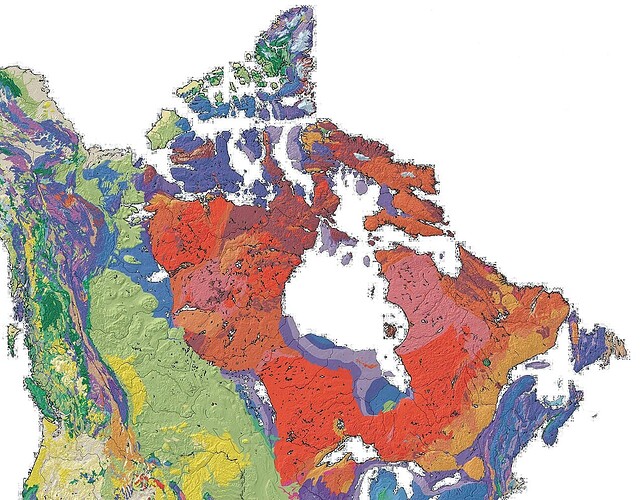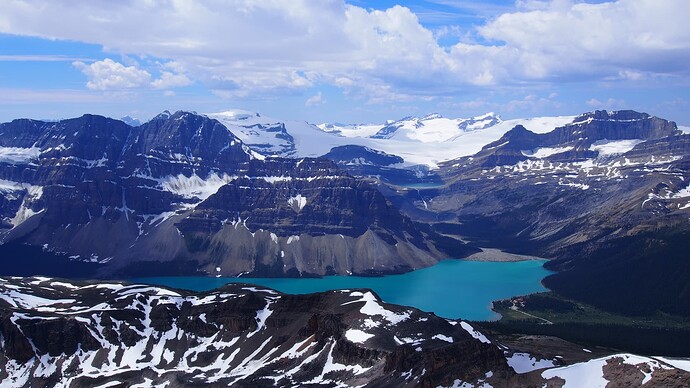We know how sediments can form and can be deposited. The question I have is this: is it possible for for a continent or Pangea for that matter, to erode itself and bury every square mile of itself under one mile of sediments? If so how?
I’ve looked at the book and its notes and references. I’m not going to waste my time reading page by page empty rhetoric and unsubstantiated claims. I will grant that it may promote an imaginative idea that has internal consistency, but when looking for objective data and measurements that would indicate it in fact is true, see nothing of substance.
Slowly.
It seems unlikely that you read this, posted earlier:
You have to understand that much continental sedimentary rock has been uplifted from oceanic deposits. Sediment forming erosion is from all kinds of rock, including igneous and sedimentary. The prairies are largely at least second generation sediment due to regular erosion, glacier flow, and the inland seaway.
Nor is it the case that every square mile of the continent buried under one mile of sediments. The massive Canadian shield, shown below in shades of red, is mostly composed of exposed igneous and metamorphic rock.
If you want to understand YEC geology, rather than a parody of it, or misunderstandings of it, you have to read and listen to YEC geologists. They have addressed many if not all of the objections in this thread. But you have to read them. I couldn’t begin to even summarize what they have written.
These geologists have much better arguments and explanations than one would think from reading only what is written here.
I would not know where to look for an academic geology article from a YEC geologist. Could you provide a link or two relevant to this thread?
are the YEC’s saying that all of these types of formations are from the global flood event? Are you saying that the only way in which any of these formations appeared on the YEC model is just Noahs flood?
that is a surprising revelation of global news for me as i was certainly not aware with any YEC geological problem in laying down additional formations as a consequence of ongoing volcanic activity which we find all around the world today that has continued unabated since Noahs flood.
Is there something in that feature in your local area that causes dating issues that says it must have been deposited during Noahs flood?
The problem is what is found between those additional formations. Absent a global flood how did the sedimentary layers form? It takes a long time to erode rock using the normal processes we see today.
Chemistry is the problem here. A layer of rock takes many years to form…far longer than at 40 or so day flood. The turbulence of the flood would make it difficult for the carbonates and other materials that from these rock layers to develop. It is possible to take a glass and put soil in it and mix it up. After a time the soil will settle out and there will be a nice layer on the bottom. It can sit for 40 days, but if you shake it up, the soil will again fill the glass. It takes a very long time for that soil to harden and form a layer that would not be disturbed upon shaking.
Try reading the thread title and the opening post.
Let alone unsorted deposits that include clay-sized particles that take multiple days to settle out of completely still water (okay, Brownian Motion is still happening, but nothing much else) alongside shells larger than my hand.
Have they yet come up with a coherent, self-consistent, and potentially viable explanation for why biostratigraphy, microfossil relative dating, stratigraphic ranges, or paleobiogeography (among other things) work?
I had a look at it the other day. A couple of observations.
First: He plays the accelerated nuclear decay card when trying to explain away radiometric dating. That alone is sufficient to write off his thesis in its entirety. Accelerated nuclear decay is the point at which young earthists fail the FizzBuzz of both nuclear physics and earth sciences. It’s basically an admission that they don’t have a leg to stand on. It’s science fiction. It didn’t happen, it’s as simple as that. Try something easier, such as persuading me you can provide me with a holodeck, a transporter room, a warp drive and a tractor beam by next Tuesday.
Second: He claims that there is no evidence for continental drift. That is another FizzBuzz failure. Continental drift can be directly measured using GPS. In fact GPS systems and high-resolution maps have to make regular adjustments to account for it.
Third: One point that I noticed before I gave up altogether on account of these two FizzBuzz failures was a denial that ice cores have hundreds of thousands of annual layers, claiming that the seasonal variations in isotope levels, dust content, acidity and so on are not statistically significant. This claim is very badly out of date at best, and at worst completely untrue. The source that he quote mines in support of it – the abstract of Dansgaard (1981) is a forty-two year old study whose objective was to overcome this very problem. Since then, many more ice cores have been taken and subjected to dozens if not hundreds of studies with vastly improved technology. Here is just one example.
So, all in all, the three short snippets that I’ve looked at tell me that it’s not worth wasting my time trying to investigate anything else he says. If this were a job interview and I were the interviewer, my response would be to move straight to the “Have you any further questions for me?” stage, and then put his CV straight in the bin the minute he was out the door.
The deep turquoise color of rocky mountain lakes is due to glacial rock flour that remains suspended in the water.
Photo mine, from Cirque Peak in Banff National Park.
How many times have I repeated this?
The other physical options to speed up radiometric decay involve messing with fundamental constants in ways that make every atom fall apart (making the electromagnetic force weaker), make protons and neutrons fall apart (making the strong nuclear force weaker), or make all neutrons turn into protons (making the weak nuclear force stronger). Incidentally, the first one would also require slowing down the speed of light, thus making ancient starlight even more of a problem.
The only options left are a (pointless and deceptive) miracle or invoking magic.
To be viable, a YEC geology model must be comprehensive, coherent, and consistent with the evidence. But YEC geology is characteristically piecemeal excuses to ignore the plain evidence of geology pointing to an ancient earth. For example, Adam asks why all the layers have to be deposited by the Flood. Plenty of young-earth advocates claim that all the layers were deposited by the Flood, but it is true and makes more sense that some layers would be pre-Flood, some during the Flood, and some after. But which ones? There’s no consistency - the Flood supposedly made layers above or below ones that supposedly are pre-or post-Flood.
If young-earth geology worked, it ought to provide information enabling someone to locate geological resources or to know what layer will have what types of fossil. It doesn’t. Every time you use petroleum products, you are demonstrating that old-earth models work.
Thank you for your question about peer review articles on YEC geology
There are some peer reviewed articles in secular scientific journals from geological creation scientists, but likely few, and I don’t know where to access them specifically, and likely neither will you. Of course, old earth or deep time geologists don’t submit their research to YEC geologists for inclusion in their peer reviewed journals either. But be assured, YEC geologists usually begin their research with a review of all the relevant research in secular journals as well, as they should.
But this article references some YEC articles published in secular science journals:
Start with the first article link below.It gives a review of peer review in general, and why YECs don’t and can’t submit articles in secular journals and have them accepted. In a real sense, why bother?
Here is where you can access peer reviewed articles by YEC scientists including those on geology.
There are some excellent books as well.
Thank you, will look at those.
Read Timothy Clarey’s Carved in Stone, Geological Evidence of the Worldwide Flood for a comprehensive, coherent model that is consistent with the evidence.
Are you claiming that when research proceeds by examining discreate pieces of the geological evidence, that it is “piecemeal” and so can be dismissed as invalid?
If the Coconino sandstone is examined for evidence as to whether it was laid down by water or by windblown desert sands, to report the evidence that strongly indicates it was laid down by water is “piecemeal?” Therefore it cannot be used as evidence for Flood geology? And since it is piecemeal, although Coconino sandstone was previously thought to be laid down by wind, evidence against a worldwide flood, it remains so because the new study simply shows that YEC geologists present evidence piecemeal? Of course not.
Are you suggesting that because some YEC geologists don’t agree, therefore conventional geology must be accepted as true?
Finding petroleum products is not based on a geologist’s understanding of the age of the rock layers. Whether YEC or OEC, looking for fossil fuels proceeds on the understanding of the geological characteristics where oil (for example) is found, not assigning the conventionally accepted age. For example, Dr. Clarey held a productive position in oil exploration prior to joining ICR as a research geologist.
Every time you use petroleum products, you are demonstrating that a competent team of geologists were able to find them regardless of their worldview.

